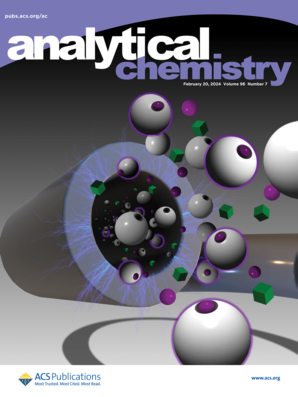Light-Induced Electrode Scanning Microscopy
IF 6.7
1区 化学
Q1 CHEMISTRY, ANALYTICAL
引用次数: 0
Abstract
Patch clamps and microelectrode arrays have been widely used to detect the electrical properties of cells in biomedicine. Yet, both technologies can record signals only in an invasive manner or at fixed positions. Based on the resolution (LAPS) and optically induced dielectrophoretic, we present a novel light-induced electrode scanning microscopy. It works like a “radar”, scans the whole area with living cells in culture, and detects the electrical signals of single cells on a photosensitive chip. In the system, a light pattern projected onto the chip is used to form the corresponding light-induced electrode, and the electrode scanning mode is implemented by moving the light pattern or the chip position for the measurement of the electrical characteristics of biological cells and cell localizations. It provides a new tool for the detection of cell electrical properties and is expected to become the next generation of electrophysiological detection technology.

光诱导电极扫描显微镜
膜片钳和微电极阵列在生物医学中被广泛用于检测细胞的电学特性。然而,这两种技术都只能以侵入性方式或在固定位置记录信号。在分辨率(LAPS)和光诱导介电泳的基础上,提出了一种新型的光诱导电极扫描显微镜。它的工作原理就像一个“雷达”,用培养的活细胞扫描整个区域,并检测光敏芯片上单个细胞的电信号。在该系统中,利用投射到芯片上的光模式形成相应的光感应电极,通过移动光模式或芯片位置来实现电极扫描模式,用于测量生物细胞的电学特性和细胞定位。它为细胞电学特性的检测提供了一种新的工具,有望成为下一代电生理检测技术。
本文章由计算机程序翻译,如有差异,请以英文原文为准。
求助全文
约1分钟内获得全文
求助全文
来源期刊

Analytical Chemistry
化学-分析化学
CiteScore
12.10
自引率
12.20%
发文量
1949
审稿时长
1.4 months
期刊介绍:
Analytical Chemistry, a peer-reviewed research journal, focuses on disseminating new and original knowledge across all branches of analytical chemistry. Fundamental articles may explore general principles of chemical measurement science and need not directly address existing or potential analytical methodology. They can be entirely theoretical or report experimental results. Contributions may cover various phases of analytical operations, including sampling, bioanalysis, electrochemistry, mass spectrometry, microscale and nanoscale systems, environmental analysis, separations, spectroscopy, chemical reactions and selectivity, instrumentation, imaging, surface analysis, and data processing. Papers discussing known analytical methods should present a significant, original application of the method, a notable improvement, or results on an important analyte.
 求助内容:
求助内容: 应助结果提醒方式:
应助结果提醒方式:


